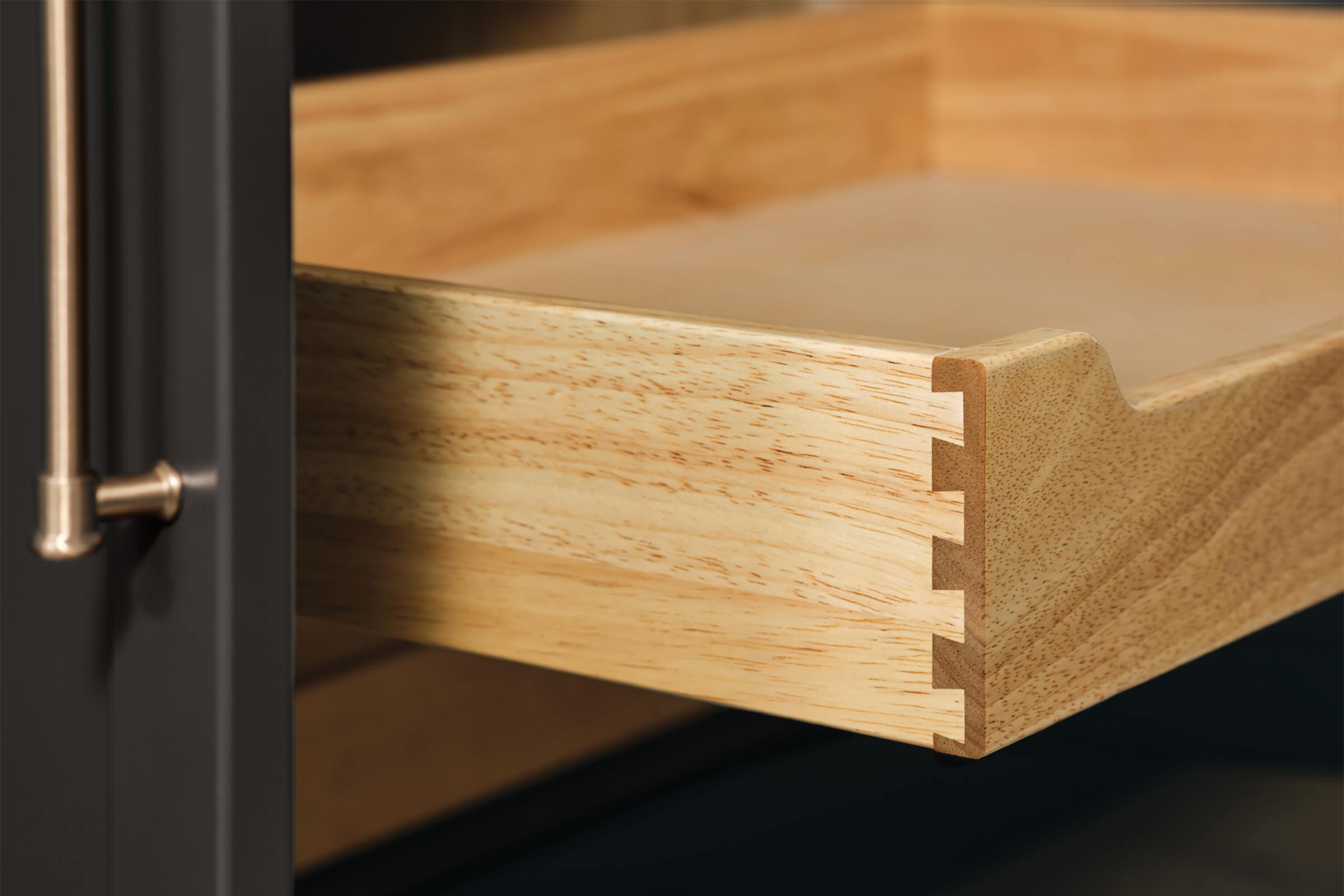Four Ways to Spot Kitchen Cabinet Quality
Posted by KraftMaid on 12th Sep 2024
There are a lot of cabinet options to choose from. And kitchen cabinet craftsmanship and quality can vary greatly from one to the next. Here are four ways to spot quality kitchen cabinets that you can love for a lifetime.
In any remodel, every dollar counts. And with kitchen cabinets representing more than a third of your total remodeling budget, you want to be sure you’re spending your money wisely. At first glance, it can be hard to determine how one cabinet is built compared to another. Here’s how to shop for quality kitchen cabinets to ensure the ones you choose will perform well and last a long time.
Four ways to spot high-quality kitchen cabinets:
- Pay attention to the small details.
- Look for clues that indicate strong construction.
- Open doors and drawers.
- Inspect the finish.
1. PAY ATTENTION TO THE SMALL DETAILS
Determining cabinet quality starts with looking at the fine details. It’s often a combination of slight design and construction nuances that make all the difference in how long a cabinet will last and how well it will perform.
- Run your fingers along the corners of the cabinet face frames and around the perimeter of each door. You want these edges to be gently softened or radiused. Eased edges resist splintering better than sharp corners. Plus, crisp corners don’t have any surface area to hold a finish, so they often leave an unsightly outline of raw wood along each edge.
- Take a closer look at the drawer boxes. Solid-wood drawer boxes with dovetail joinery on all four corners indicate a durable, well-built cabinet.
- Ask about the materials used in the cabinet. Most top-quality cabinet doors, drawers and face frames will feature solid hardwoods, Alder, Cherry, Hickory, Maple and Oak. Cabinet boxes may be constructed of plywood or furniture board. (The thickness of the cabinet box components is as important as the material. Quality cabinets will have a minimum of 1/2"-thick end panels and shelves, while premium cabinets often feature 3/4"-thick components.)
- Inspect the hardware. High-grade hinges and drawer glides from a leading manufacturer, like Blum, will deliver a lifetime of smooth operation. Best-in-class cabinets will also include hardware extras, like soft-close dampers and two-piece, clip-on hinges that allow you to remove and replace doors without using tools.

Solid hardwood door frames and face frames signify a cabinet is made of quality materials.
2. LOOK FOR CLUES THAT INDICATE STRONG CONSTRUCTION
Cabinet construction methods are directly tied to overall strength and durability. High-quality cabinetry will share many of the same techniques you’d find in fine furniture.
- Avoid cabinets that are simply placed together and fastened. Insist on cabinets that use overlapping or interlocking joinery to connect cabinet box panels. These methods improve alignment between components and increase overall gluing surface for stronger joints.
- Lesser-quality cabinets may use plastic braces or small wood triangles to reinforce base cabinet corners. Better-quality cabinets use I-beam construction – a wide plank that sits in a groove on the side panels and runs the full depth of the cabinet box. This construction method helps to keep cabinets strong, stable and square throughout installation.
- Door frames should feature mitered, mortise and tenon, or cope and stick joinery to increase strength.
- Want extra protection? Ask about engineered material options designed to maximize durability. For example, KraftMaid® EverCore® is a super smooth, grain-free surface that’s designed to minimize shrinking and swelling with changes in temperature and humidity – making it an excellent option for painted cabinetry. Additionally, our CoreGuard® Sink Bases are made entirely of a sturdy polymer that won’t absorb leaks where moisture can be a frequent issue.
If you don’t have access to cabinets you can see from all sides, ask your designer about how the cabinet is made. Or check out the manufacturer’s website for specific construction details.

Look for furniture-grade joinery, like this cope and stick joint, connecting cabinet door frame components.
3. OPEN DOORS AND DRAWERS
The way a cabinet operates can offer clues to its overall quality. Do the doors, drawers and interior storage accessories open and close smoothly? Does the drawer open past the front of the cabinet so you have full access to the storage within?
While you’ve got everything open, look for more quality indicators.
- Drawers with deep sides allow you to hold more items inside without them tumbling out.
- Note where drawer glides are installed. Unlike side-mounted glides, bottom-mounted drawer glides allow the drawer box to stretch the full width of the drawer opening, maximizing usable storage.
- Top-quality cabinets will feature hinges with adjustment screws that let you fine-tune door fit and alignment.

Examining how drawers are built and how they operate can help you evaluate the overall quality of a cabinet.
4. INSPECT THE FINISH
Even the best-built cabinets won’t seem like it without a beautiful finish. Here are a few ways to tell you’re getting a high-quality cabinet finish.
- Ask how many coats of finish are applied. Multiple coats of hand-rubbed stains and wood toners can produce a deeper, richer look. Several coats of precisely applied enamel paint provide more even coverage. A clear topcoat, hardened by oven curing, can protect stains and paints against smudges and scratches.
- Touch the doors and drawer fronts. A silky texture can indicate the wood was thoroughly sanded prior to finishing in a dust-free environment.
- The 14-step proprietary process in the KraftMaid DuraKraft™ Plus Finishing System includes all of the above to ensure you get a flawless, long-lasting finish.

Durability is a must for the kitchen. Better-quality cabinets will feature a protective topcoat.
INSIST ON KRAFTMAID® QUALITY
Perhaps the easiest way to be sure you’re getting quality cabinets is to look for the KraftMaid logo. We’re obsessed with quality and fanatical about craftsmanship – to the degree that every cabinet we build features 78 individual quality points. And counting. See them all at 78pointsandcounting.com.
